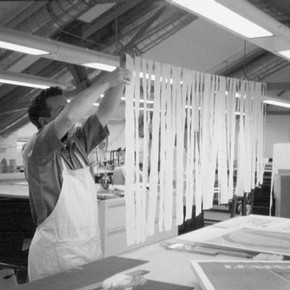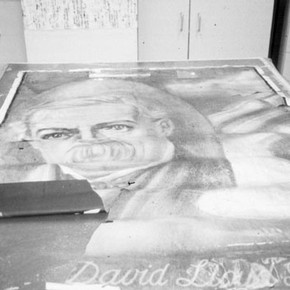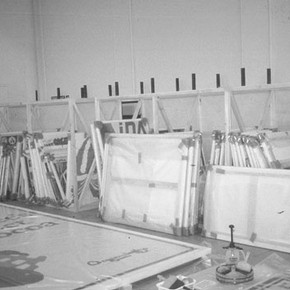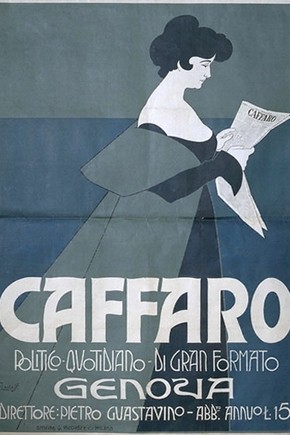Conservation Journal
October 1998 Issue 29
The Power of the Poster and Paper Conservation
Following the recent Power of the Poster exhibition this article aims to describe the wider role of the Paper Conservation Section before, during and after the exhibition.
Posters at the V&A

Figure 1. Chris Gingell preparing the strips of Japanese paper with Lascaux as described in the text. Photograph by Pauline Webber (click image for larger version)
The Victoria and Albert Museum collects posters on an international scale, with over 10,000 objects in the Prints and Drawings Department, and significant holdings in other departments. The Museum has had an active collecting policy throughout the twentieth century and now holds the national collection. Posters have an immediate impact and as a medium of communication have a fascinating appeal. They can be active forces for change, as propaganda, social documents and as an art form.
The history of posters demonstrates the application of art to commercial and industrial printing, resulting in a liberating and exciting art form. The importance of the Museum's collection lies in its technical and artistic merit, the emphasis of collecting policy being the 'artist poster'; thus the collection can be seen as not only an archive of social and political change but as a history of lithographic art.
The Poster
A poster is defined as 'a placard posted or displayed in a public place as an announcement or advertisement' 1 . Although the poster, in various guises, is not a modern development - very early posters were produced using a variety of techniques - it was the innovation and use of high speed colour lithography by Jules Cheret in the nineteenth century that brought the art form to the masses. The majority of posters are printed by offset lithography. Posters have general characteristics of size, shape and material, usually being printed on to standard formats of machine-made woodpulp paper, but the variety of messages and styles is staggering. In recent years the deployment of posters has become increasingly inventive with adverts that use lights, optical and even olfactory illusions 2 . The size of posters is dictated by the space they might fill, from small advertisements to huge roadside hoardings and The Power of the Poster has attempted to reflect the breadth and wealth of poster design.
Poster Exhibitions at the V&A
The Exhibition of British and Foreign Posters held in 1931 recognised the active collecting policy of the V&A. The display of 650 posters was in itself a further impetus to acquisition, and many posters were received as gifts and bequests. Numerous smaller specialist poster exhibitions have been held since, such as London Transport Posters in 1949 and the Mucha exhibition of 1963, but The Power of the Poster exhibition this year was only the second major exhibition of posters to be held. The Power of the Poster aimed to show approximately 350 posters from the Museum's own holdings and to offer some of the best examples of poster art from the nineteenth and twentieth centuries.
The exhibition was divided into three key areas, each being individually curated. 'Leisure and Pleasure' focussed on the development of arts and entertainment posters; 'Protest and Propaganda' showed powerful images used to promote political, moral and social messages; 'Products and Services' showed commercial advertising posters. Approximately half the V&A's collection is of British posters, although all the sections included familiar and unfamiliar images from throughout the world.
Exhibition Planning

Figure 2. The reverse of the Derry and Tom poster by Bylitiplis WS, Museum No. E.15-1920, after the old linings have been removed. Photograph by Pauline Webber (click image for larger version)
An exhibition of this scale requires a great deal of planning, communication and time and preparations for the poster exhibition began well in advance of its formal agreement; for example with a survey of 'oversize' works on paper in 1993. Information gained from this and further surveys assisted in the projection of conservation estimates. Although the list of posters for the exhibition was constantly changing, the majority were surveyed during the summer of 1997. Condition ratings from 1(Good) to 4(Unacceptable) were used 3 , and the results were as follows:- Condition 1 - 11%, Condition 2 - 43%, Condition 3 - 34%, Condition 4 - 4%.
All the posters were measured at this stage as well to enable the mounts to be made in time. Recommendations to the exhibition designer regarding the mounting and display of the posters were made during regular project team meetings between Conservation, Design, Exhibition, Curatorial and other staff concerned. These meetings were a time of patience, diplomacy and flexibility and were usually positive, clearing any misunderstandings and allowing the project to progress smoothly.
Conservation
By September 1997 the final list had been drawn up and a full assessment was made of the conservation required. Work was prioritized and time-tabled. Planning was essential due to the large scale of the exhibition itself and of the objects. The 'average' poster was approximately 1000 x 750mm and the largest 4100 x 3100mm, so space in the studio was at a premium and good organization critical. The posters chosen for the exhibition ranged in date, size and condition. Most of the more modern examples required little except mounting, yet the majority needed some treatment.
Posters are generally lithographically printed on to fairly poor-quality short-fibred paper. Due to their nature the vast majority of posters have previously undergone restoration or conservation before or after acquisition. This is generally some form of lining with, over time, a wide range of backing methods having been applied. Some retain the cloth that was often applied by the printers when selling directly to dealers, others have laminated backings of canvas and heavy machine-made papers. Occasionally an 'impregnated starched cotton' has also been used, and more recently treatment tends to be linings of western wove or oriental papers. The majority of adhesives tend to be water soluble, ranging from manufactured starch pastes used in the 50's, to carboxy methyl cellulose. Nowadays, wheat starch paste is commonly used.

Figure 3. Posters ready for hanging being stored in the preparation area in the North Court. Photograph by Alison Norton (click image for larger version)
Many of the posters required re-lining due to the failure of the adhesive which resulted in delamination. Previous lining methods were often too heavy, which caused distortion and deformation. Other problems included discolouration and increased brittleness of the paper, surface and ingrained dirt, splits, cracks, tears and losses. Poor handling and poor storage have also contributed, with damage resulting from repeated flexing, folding or rolling. Full treatment of the posters involved surface cleaning, the removal of old linings and adhesive, 'blotter washing', relining with a japanese paper, repair, infilling of losses and some retouching. The majority of treatments were, however, fairly standard.
The printing inks used can generally withstand wet treatment, although the red inks, especially on the continental posters, were more susceptible. The posters were lined with sekishuu japanese mulberry paper and zin shofu paste (a purer, japanese form of wheat starch). Infills and losses were retouched using watercolour, pastel and coloured carbon pencils. Interesting exceptions to this 'standard treatment' included a Russian okno (a window poster of 12 panels produced with a stencil), a Japanese Kabuki theatre poster, the original collage for the Sex Pistols' Never Mind the Bollocks and hand-coloured suffragette posters.
The size and flexibility of the new Paper Conservation studio were used to the full. Fixed furniture had been kept to a minimum in the design, which enabled the large central floor space to be used with trestle worktops in a variety of configurations forming large work surfaces. The specifications for the floor had included the ability to tolerate water treatments, and in the case of the largest posters the floor was used as a working surface. However, the largest posters did have to be mounted in the exhibition area because, despite a large studio, the lift was too small.
Exhibition Design and Mounting
Liaising with the exhibition designer was a critical part of the preparation process, and ensured that the mounting and presentation of the posters in the space provided had an aesthetic coherence. Early suggestions of coloured walls and curved ceilings were abandoned, partly for lack of funds but largely for aesthetic considerations, and it was agreed to 'let the posters do the talking'. The overall atmosphere was clean and sharp, with the walls painted an off-white. The North Court glass roof was covered and a white fabric stretched across to bounce light back into the gallery. Sight lines were kept open throughout the gallery and information panels were kept simple. The posters were hung in groups within the three distinct sections, and the height of some internal walls reduced to make the overall design less overpowering. The effect of the number and size of posters was intense.

Figure 4. Caffaro, by Franz Laskoff, Museum No. E1414-1963, on display in the exhibition. Photograph by Mike Webber (click image for larger version)
It had been decided at an early stage to mount the posters in an untraditional way, unframed and unglazed, to maximise their impact and allow them to be presented in a suitably sympathetic fashion which reflected their form and function. The majority of the posters were thus displayed on rigid supports or 'subframes' 4 made of a wooden strainer with GatorfoamTM attached. The edges of the subframes were sanded and covered with Archive TextTM .
The posters were positioned on to the subframes and mounted with further strips of Archive TextTM pasted with wheat starch, holding them flat and taut but without tension. The more modern and unlined posters (without reinforcing strips of a putative lining by which to hold them), were attached to the subframes using minogami or usimino japanese paper strips attached to the object with Lascaux Acrylic Adhesive 360HVTM , a heat-activated adhesive.
This simple, effective method of mounting allowed the posters to be presented in a manner that contributes to, rather than diminishes their being understood. It could be seen as a prototype for a standard form of display facilitating both attachment and later removal. The mounts are easy to construct and can be used for travelling exhibitions, although - GatorfoamTM is not at present recommended for long-term storage. The largest posters were suspended from the roof vaulting on wires which could each carry 130kg. Wooden strainers covered in TheatexTM - an imported 5m wide polyester often used in theatre backdrops - acted rather like 'cami-linings' 5 , were used as supports for the posters and were attached using strips of japanese mulberry minogami.
Some of the posters had to be framed, for example those with sensitive media, working drawings, those in areas where space was tight or access required (eg. fire exits), and those with loan and museum restrictions. A distance of 1.2m had to be kept between the visitor and unglazed objects, which in this case was provided by a low stretch barrier, and warding staff prevented any vandalism or damage. The use of the subframes, and the opportunity to view the objects unglazed, enhanced the exhibition and harmonised well with the overall design, contributing to the general success of The Power of the Poster.
Exhibition and Environment
The exhibition was open for almost four months and has been one of the Museum's most successful, with attendance figures of almost 200,000. Conservation and Exhibition staff monitored the posters throughout, and there was no obvious damage or change to any of the works on display. All that was required was simply the brushing away of a light covering of dust from the top edges of the subframes. Although the exhibition areas do not at present operate under the strictest environmental controls, fluctuations in humidity and temperature were not extreme; the largest posters - where any change would be reflected in dimensional movement - remained unaltered and well mounted, without either sagging or cockling.
Future Plans
The de-installation of the poster exhibition has just been completed. The original plan had been to remove the posters from their subframes and encapsulate them before their return to the poster store. However it is likely that the exhibition will be travelling to Sheffield for display within the next two years. Therefore, after condition checking, the objects will be stored in their present condition as a unit. Each poster on its subframe was wrapped in Archive TextTM and bubble wrap, the framed objects simply protected with bubble wrap, and the larger objects removed from their strainers, carefully rolled around large plastic tubes and protected on the outside.
The exhibition has offered the opportunity to spend a concentrated period of time working on the poster collection, not just on those chosen for the exhibition, and it is hoped that this can be continued. In May 1998 a further survey of the Poster Store on level F of the Henry Cole Wing was carried out. This store holds over 1000 objects including the largest works. An ongoing programme of work has begun, prioritising those posters in poorest condition.
Posters are a very public art form and the V&A strives to keep its posters accessible, through major exhibitions, temporary displays and loans. It is also planning to develop a new storage and permanent display area.
Acknowledgements
With thanks to all in the Paper Conservation studio, Margaret Timmers and all those involved in the Poster exhibition.
Suppliers
Zin Shofu and Archive Text paper, 85gsm - Conservation by Design, Timecare Works, 60 Park Road West, Bedford MK41 7SL
Sekishu, Minogami, Usomino paper - Masumi Corporation, 4-5-2 Sugamo, Tokyo 170, Japan
Gatorfoam - Europoint Display, Units 1&2, Bricklayers Arms, Mandela Way, London SE1 5SL
Lascaux 360HV - Lascaux Restauro, CH-8306 Bruttisellen, Switzerland
Theatex - 'Trevyra White' (Polyester White), 5 m wide - Spoorlaan 8a, 3645 EJ Vinkereen, Holland
References
1. The Shorter Oxford English Dictionary, Oxford University Press, 1973.
2. Timmers, M., Introduction in Timmers, M., ed. The Power of the Poster, V&A Publications, London, 1998, pp7-25.
3 . Keene, S., 'Audits of Care: A Framework for Collections Condition Surveys', Storage: Papers given at UKIC Conference, Restoration 91, UKIC, London, 1991.
4. 'Subframe' was coined by exhibition designer Mike Malham to distinguish between this and other mounting methods.
5. 'Cami-lining' was developed by Peter Booth at the Tate Gallery and described in Booth, P., Stretcher Design: Problems and Solutions, The Conservator, 13, 1989, pp.31-40.
October 1998 Issue 29
- Editorial - Communication
- The Cosimo Panel
- 50 Years of Following In Grinling Gibbons' Tool Cuts
- Cracking Crizzling - Eight Years of Collaborative Research
- The Power of the Poster and Paper Conservation
- The RCA/V&A Conservation Course Study Trip
- Science Surgery
- Editorial Board & Disclaimer
- Printer Friendly Version